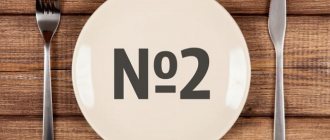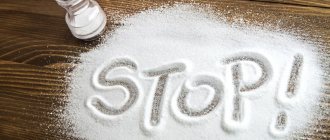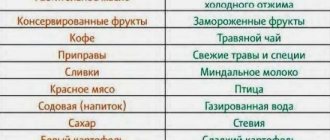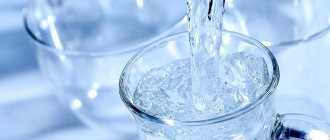Diet for youth: nutritional features during menopause
It is no secret that a woman’s health and appearance depend on proper and healthy nutrition. And if in their youth many beauties can sometimes indulge themselves with fast food and Coca-Cola without worrying about the consequences, then in older age they should carefully select their daily diet.
With age, every woman faces such an unpleasant phenomenon as menopause or menopause. During this period, the body reduces the synthesis of the main female sex hormone - estrogen, which leads to the cessation of reproductive function. Most representatives of the fair sex expect menopause as if it were a catastrophe, however, it is quite possible to reduce unpleasant symptoms and prolong the youth of the body if you reconsider your habits and lifestyle, and also follow a non-strict diet.
Menopause and its features
Each woman experiences menopause differently, but the general symptoms are the same. First, the production of female hormones by the ovaries decreases, menstruation is disrupted, the possibility of becoming pregnant decreases, and finally disappears. Most often, the first symptoms of menopause are observed around 50 years of age, but there are cases when menopause occurs at 40 years of age or even earlier. The reason for this may be genetic predisposition, chronic diseases, poor diet and bad habits.
Not every body tolerates menopause without pronounced symptoms. About 70% of women experience sudden hot flashes, profuse sweating, swelling, nausea and insomnia. In more rare cases, menopause causes serious disorders of the nervous, endocrine and cardiovascular systems.
Menopause in women is usually divided into three stages: premenopause, menopause and postmenopause. The first stage lasts on average 2-5 years and covers the period from the beginning of the decline of ovarian function until the onset of menopause itself. During the next period, there is a gradual cessation of menstrual flow. The third period - postmenopause - is the time after the cessation of menstruation.
Authorized Products
The basis of the diet during menopause in women is:
- Whole grain/rye bread, oatmeal cookies, crispbread.
- Lean fish, seafood.
- Chicken eggs in the form of steam omelet, soft-boiled eggs.
- Veal, beef, domestic chicken, rabbit, turkey, prepared by boiling.
- Non-starchy vegetables (cucumber, green beans, spinach, asparagus, onions, green peas, all types of cabbage, garden herbs, garlic, zucchini, celery greens, lettuce, sweet peppers in any form, both separately and in the form of salads) .
- Fermented milk/low-fat dairy products (ryazhenka, kefir, cottage cheese, acidophilus milk, cheese).
- Unrefined virgin vegetable oils (sunflower, flaxseed, olive), seeds/nuts of various types.
- Weak green and herbal tea, freshly prepared juices, rosehip infusion, still mineral water.
Table of permitted products
| Proteins, g | Fats, g | Carbohydrates, g | Calories, kcal | |
Vegetables and greens | ||||
| greenery | 2,6 | 0,4 | 5,2 | 36 |
| boiled peas | 6,0 | 0,0 | 9,0 | 60 |
| zucchini | 0,6 | 0,3 | 4,6 | 24 |
| broccoli | 3,0 | 0,4 | 5,2 | 28 |
| Brussels sprouts | 4,8 | 0,0 | 8,0 | 43 |
| cabbage | 1,2 | 0,2 | 2,0 | 16 |
| watercress | 2,3 | 0,1 | 1,3 | 11 |
| red onion | 1,4 | 0,0 | 9,1 | 42 |
| bulb onions | 1,4 | 0,0 | 10,4 | 41 |
| carrot | 1,3 | 0,1 | 6,9 | 32 |
| cucumbers | 0,8 | 0,1 | 2,8 | 15 |
| olives | 0,8 | 10,7 | 6,3 | 115 |
| salad pepper | 1,3 | 0,0 | 5,3 | 27 |
| arugula | 2,6 | 0,7 | 2,1 | 25 |
| beet | 1,5 | 0,1 | 8,8 | 40 |
| celery | 0,9 | 0,1 | 2,1 | 12 |
| tomatoes | 0,6 | 0,2 | 4,2 | 20 |
| dill | 2,5 | 0,5 | 6,3 | 38 |
| garlic | 6,5 | 0,5 | 29,9 | 143 |
Fruits | ||||
| baked sweet and sour apples | 0,5 | 0,5 | 12,3 | 59 |
Berries | ||||
| grape | 0,6 | 0,2 | 16,8 | 65 |
Mushrooms | ||||
| mushrooms | 3,5 | 2,0 | 2,5 | 30 |
Cereals and porridges | ||||
| oatmeal with water | 3,0 | 1,7 | 15,0 | 88 |
| wheat bran | 15,1 | 3,8 | 53,6 | 296 |
Bakery products | ||||
| whole grain bread | 10,1 | 2,3 | 57,1 | 295 |
Dairy | ||||
| kefir 1% | 2,8 | 1,0 | 4,0 | 40 |
Cheeses and cottage cheese | ||||
| cottage cheese | 17,2 | 5,0 | 1,8 | 121 |
| cottage cheese 1% | 16,3 | 1,0 | 1,3 | 79 |
Meat products | ||||
| lean beef | 22,2 | 7,1 | 0,0 | 158 |
| veal | 19,7 | 1,2 | 0,0 | 90 |
| rabbit | 21,0 | 8,0 | 0,0 | 156 |
Bird | ||||
| boiled chicken breast | 29,8 | 1,8 | 0,5 | 137 |
| steamed chicken breast | 23,6 | 1,9 | 0,0 | 113 |
| boiled chicken fillet | 30,4 | 3,5 | 0,0 | 153 |
| turkey | 19,2 | 0,7 | 0,0 | 84 |
Eggs | ||||
| hard-boiled chicken eggs | 12,9 | 11,6 | 0,8 | 160 |
Fish and seafood | ||||
| boiled fish | 17,3 | 5,0 | 0,0 | 116 |
| pink salmon | 20,5 | 6,5 | 0,0 | 142 |
| squid | 21,2 | 2,8 | 2,0 | 122 |
| shrimps | 22,0 | 1,0 | 0,0 | 97 |
| salmon | 19,8 | 6,3 | 0,0 | 142 |
| mussels | 9,1 | 1,5 | 0,0 | 50 |
| seaweed | 0,8 | 5,1 | 0,0 | 49 |
| zander | 19,2 | 0,7 | — | 84 |
| cod | 17,7 | 0,7 | — | 78 |
| trout | 19,2 | 2,1 | — | 97 |
| hake | 16,6 | 2,2 | 0,0 | 86 |
| pike | 18,4 | 0,8 | — | 82 |
Oils and fats | ||||
| vegetable oil | 0,0 | 99,0 | 0,0 | 899 |
| linseed oil | 0,0 | 99,8 | 0,0 | 898 |
Non-alcoholic drinks | ||||
| mineral water | 0,0 | 0,0 | 0,0 | — |
| instant chicory | 0,1 | 0,0 | 2,8 | 11 |
| green tea | 0,0 | 0,0 | 0,0 | — |
Juices and compotes | ||||
| rose hip juice | 0,1 | 0,0 | 17,6 | 70 |
| * data is per 100 g of product | ||||
Signs of menopausal syndrome
The first and main symptom of menopause is a decrease in the production of female hormones. A woman can replace the decrease in hormone levels due to disruptions in the menstrual cycle. There are long delays in menstruation, and the discharge itself can become either abundant or scanty. At this time, uterine bleeding may also occur, which can sometimes lead to anemia, which should be taken into account when choosing a diet.
Among the most common symptoms of menopause are:
- Insomnia.
- Depression.
- Feeling of fear.
- General anxiety.
- Headache.
- "Floaters" before the eyes.
- Hypertension.
- Sudden weight changes.
- Chills.
- Fast fatiguability.
It is worth noting that all of the above signs may not only indicate the onset of menopause, but also be symptoms of other diseases. That is why, if all the above symptoms appear, it is necessary to undergo an examination prescribed by a doctor, who will select the right diet and, if necessary, prescribe treatment.
TAKE THE TEST to determine the severity of menopausal syndrome and receive PERSONAL RECOMMENDATIONS during menopause on the website mense.ru
Take the test
Fully or partially limited products
In the diet for menopause in women, it is prohibited to consume:
- Fatty varieties of sea/river fish, canned fish, caviar of various fish.
- Fatty meat and meat products (semi-finished meat products, canned meat, offal, bacon, sausages, smoked meats, ham), fast food products.
- Animal fats, duck/goose meat, mayonnaise, high-fat dairy/fermented milk products (butter, cream, cheese, fermented baked milk, sour cream, cottage cheese).
- White rice, pasta.
- Products containing simple carbohydrates (jam, chocolate, candies, honey, sugar, confectionery, sweet drinks, condensed milk, waffles, preserves, ice cream, sweet fruits, semolina).
- Salted/pickled foods, salt, preservation.
- Vegetables containing starch (beets, corn, potatoes, eggplants).
- Black tea, strong coffee, alcohol-containing and sweet drinks with carbon dioxide.
Table of prohibited products
| Proteins, g | Fats, g | Carbohydrates, g | Calories, kcal | |
Vegetables and greens | ||||
| vegetables legumes | 9,1 | 1,6 | 27,0 | 168 |
| potato | 2,0 | 0,4 | 18,1 | 80 |
| horseradish | 3,2 | 0,4 | 10,5 | 56 |
Fruits | ||||
| bananas | 1,5 | 0,2 | 21,8 | 95 |
| melon | 0,6 | 0,3 | 7,4 | 33 |
| figs | 0,7 | 0,2 | 13,7 | 49 |
| mango | 0,5 | 0,3 | 11,5 | 67 |
Berries | ||||
| grape | 0,6 | 0,2 | 16,8 | 65 |
Nuts and dried fruits | ||||
| raisin | 2,9 | 0,6 | 66,0 | 264 |
| dates | 2,5 | 0,5 | 69,2 | 274 |
Snacks | ||||
| potato chips | 5,5 | 30,0 | 53,0 | 520 |
Cereals and porridges | ||||
| porridge | 3,3 | 1,2 | 22,1 | 102 |
| white rice | 6,7 | 0,7 | 78,9 | 344 |
Flour and pasta | ||||
| pasta | 10,4 | 1,1 | 69,7 | 337 |
| pancakes | 6,1 | 12,3 | 26,0 | 233 |
| vareniki | 7,6 | 2,3 | 18,7 | 155 |
| pancakes | 6,3 | 7,3 | 51,4 | 294 |
| dumplings | 11,9 | 12,4 | 29,0 | 275 |
Bakery products | ||||
| buns | 7,2 | 6,2 | 51,0 | 317 |
| wheat bread | 8,1 | 1,0 | 48,8 | 242 |
Confectionery | ||||
| jam | 0,3 | 0,2 | 63,0 | 263 |
| jam | 0,3 | 0,1 | 56,0 | 238 |
| candies | 4,3 | 19,8 | 67,5 | 453 |
| cookie | 7,5 | 11,8 | 74,9 | 417 |
| cake | 3,8 | 22,6 | 47,0 | 397 |
| jam | 0,4 | 0,2 | 58,6 | 233 |
| dough | 7,9 | 1,4 | 50,6 | 234 |
| halva | 11,6 | 29,7 | 54,0 | 523 |
Cakes | ||||
| cake | 4,4 | 23,4 | 45,2 | 407 |
Chocolate | ||||
| chocolate | 5,4 | 35,3 | 56,5 | 544 |
Raw materials and seasonings | ||||
| seasonings | 7,0 | 1,9 | 26,0 | 149 |
| mustard | 5,7 | 6,4 | 22,0 | 162 |
| ginger | 1,8 | 0,8 | 15,8 | 80 |
| mayonnaise | 2,4 | 67,0 | 3,9 | 627 |
| honey | 0,8 | 0,0 | 81,5 | 329 |
| sugar | 0,0 | 0,0 | 99,7 | 398 |
| vinegar | 0,0 | 0,0 | 5,0 | 20 |
Dairy | ||||
| milk | 3,2 | 3,6 | 4,8 | 64 |
| milk 3.2% | 2,9 | 3,2 | 4,7 | 59 |
| condensed milk | 7,2 | 8,5 | 56,0 | 320 |
Cheeses and cottage cheese | ||||
| cheese | 24,1 | 29,5 | 0,3 | 363 |
| amber processed cheese | 7,0 | 27,3 | 4,0 | 289 |
| cottage cheese 18% (fat) | 14,0 | 18,0 | 2,8 | 232 |
Meat products | ||||
| fatty pork | 11,4 | 49,3 | 0,0 | 489 |
| pork fat | 1,4 | 92,8 | 0,0 | 841 |
| bacon | 23,0 | 45,0 | 0,0 | 500 |
Sausages | ||||
| boiled sausage | 13,7 | 22,8 | 0,0 | 260 |
| smoked sausage | 28,2 | 27,5 | 0,0 | 360 |
| smoked sausage | 9,9 | 63,2 | 0,3 | 608 |
| sausages | 10,1 | 31,6 | 1,9 | 332 |
| sausages | 12,3 | 25,3 | 0,0 | 277 |
Bird | ||||
| smoked chicken | 27,5 | 8,2 | 0,0 | 184 |
| duck | 16,5 | 61,2 | 0,0 | 346 |
| goose | 16,1 | 33,3 | 0,0 | 364 |
Fish and seafood | ||||
| salted fish | 19,2 | 2,0 | 0,0 | 190 |
| caviar | 36,0 | 10,2 | 0,0 | 123 |
| cod roe | 24,0 | 0,2 | 0,0 | 115 |
| canned fish | 17,5 | 2,0 | 0,0 | 88 |
| semi-finished fish products | 12,5 | 6,7 | 14,7 | 209 |
Oils and fats | ||||
| butter | 0,5 | 82,5 | 0,8 | 748 |
| creamy margarine | 0,5 | 82,0 | 0,0 | 745 |
| coconut oil | 0,0 | 99,9 | 0,0 | 899 |
| vegetable-fat spread | 0,0 | 40,0 | 0,0 | 360 |
| animal fat | 0,0 | 99,7 | 0,0 | 897 |
| cod liver oil | 0,0 | 99,8 | 0,0 | 898 |
| cooking fat | 0,0 | 99,7 | 0,0 | 897 |
Alcoholic drinks | ||||
| white dessert wine 16% | 0,5 | 0,0 | 16,0 | 153 |
| vodka | 0,0 | 0,0 | 0,1 | 235 |
| cognac | 0,0 | 0,0 | 0,1 | 239 |
| liquor | 0,3 | 1,1 | 17,2 | 242 |
| beer | 0,3 | 0,0 | 4,6 | 42 |
Non-alcoholic drinks | ||||
| cola | 0,0 | 0,0 | 10,4 | 42 |
| coffee | 0,2 | 0,0 | 0,3 | 2 |
| Pepsi | 0,0 | 0,0 | 8,7 | 38 |
| sprite | 0,1 | 0,0 | 7,0 | 29 |
| energy drink | 0,0 | 0,0 | 11,3 | 45 |
| * data is per 100 g of product | ||||
Basic principles of the postmenopausal diet
First of all, menopause is the extinction of the ovaries and the cessation of the production of female sex hormones estrogen. These processes, on the one hand, cause a slowdown in metabolism. On the other hand, the body strives to build up adipose tissue, which also produces estrogens (albeit to a lesser extent than the ovaries), so women’s appetite increases sharply. There is a third aspect: menopause leads to a decrease in emotional background and depression, and food for many is the most accessible and fastest antidepressant. The combination of these factors is often accompanied by intense weight gain. That is why the primary task of the postmenopausal diet is to prevent a sharp increase in body weight.
According to the calculations of nutritionists, the average daily calorie intake should not exceed 2,100 kilocalories. It is also very important to balance your nutrient intake. The daily diet should include increased amounts of the following components:
- B vitamins, as well as vitamins D, C, E;
- dietary fiber and natural fiber;
- magnesium, calcium, chromium, etc.;
- antioxidants;
- unsaturated fatty acids such as Omega-6 and Omega-3;
- live bacteria - probiotics.
Today, many special vitamin and mineral complexes have been developed to support women during menopause, so it is worth paying attention to them and including them in your diet.
How to deal with symptoms?
There are three main areas of treatment - hormonal and non-hormonal therapy, and the help of a psychologist. The program is compiled by a gynecologist who takes into account symptoms and concomitant pathologies.
Hormone replacement therapy
Hormone replacement therapy (HRT) is one of the most effective ways to manage menopausal symptoms today. To do this, doctors select hormonal drugs that compensate for the lack of necessary hormones.
With the help of hormonal therapy, a gynecologist can reduce the intensity and frequency of hot flashes, reduce discomfort and discomfort, and normalize the emotional state.
However, hormone therapy can cause various side effects. These include discomfort in the chest, spotting, headaches, vomiting and nausea. Sometimes swelling occurs. These are complications that require correction of the course of treatment.
Non-hormonal therapy
If there are contraindications to hormonal therapy, the gynecologist can select spot medications that help reduce the symptoms. These drugs include antihypertensives, antidepressants, and antiepileptic drugs. Additionally, the doctor can determine medications for insomnia.
Unfortunately, there is no universal drug that would help with all symptoms at once. Therefore, a woman will have to take several medications at once, each of which may have its own side effect.
Psychotherapy for menopause
To reduce the manifestations of emotional instability, a woman can turn to a psychologist. With its help, you can normalize relationships with people and reduce the level of irritability.











